Pictures by Drew Grey (member of the Arsenal Advisory Board), Text by Tony Attwood (AISA Arsenal History Society).
Making the Arsenal stadium iconic has always been part of Arsenal’s thinking – right from the moment when Arsenal moved from Plumstead to north London in 1913. As we have recorded on this site, the changing of the name of the underground station on 31 October 1932 from Gillespie Road to “Arsenal (Highbury Hill)” 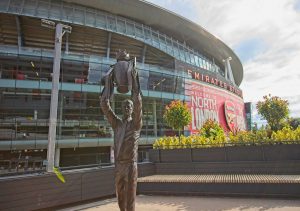 was itself an iconic moment. It became just “Arsenal” in 1960 and remains the only underground station named after a football club.
was itself an iconic moment. It became just “Arsenal” in 1960 and remains the only underground station named after a football club.
For many years the AISA Arsenal History Society has been a focus point for recording the history of the club in as many different ways as possible and it was in relation to this that on 23 July
2010, the notion of erecting a set of statues around the ground was put forward in a meeting between three committee members of AISA and Ivan Gazidis who was at the time chief executive at Arsenal. Ivan Gazidis presented the problem that he perceived Arsenal to have, by saying that the club wanted to make the stadium be more clearly “Arsenal”. The name was now “The Emirates Stadium” and that was a valuable source of income for the club, but it meant that the old iconic name of “Highbury” had been lost.
In response I put to the meeting the notion of statues, pointing to the highly symbolic place they have not only in the UK’s history, but particularly in London where
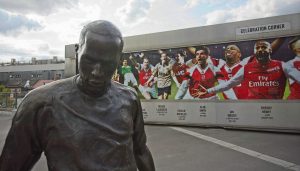
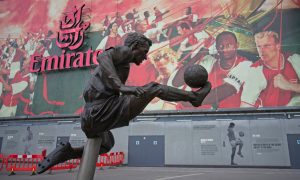
it is generally quoted that there are over 260 statues. “It would be,” I argued, “a statement about the iconic place that Arsenal FC holds within the history of the capital city to have statues commemorating the history of the city’s most famous and most successful club.
I rather thought I was going to be answered by a general vague “that’s an interesting idea” comment but in fact from the off Mr Gazidis was incredibly positive about the thought, especially when I took the matter a little further by saying that statues would help reduce congestion before the match.
For at that time many supporters would agree to meet each other at one of the entry gates, which of course added to the inevitable congestion of people wanting to get into the ground. “I think that with statues they would be inclined to say, “I’ll meet you at Tony Adams”.
The idea obviously immediately caught Mr Gazidis imagination and for the rest of the meeting we spoke of nothing but the statues.
I was invited to put my proposal in writing, which I did of course, being totally knocked out by the fact that an idea of mine had been taken so seriously, and I set out the details the following week.
That proposal included a statue to Herbert Chapman looking up at the new stadium as if to say, “I did that,” (thus representing the totally new Arsenal that was generated after he was appointed manager by Sir Henry Norris). That idea I think was fully accepted, and the resultant Chapman statue was exactly what I had in mind.
It has taken 13 years to get from that original meeting to Wenger’s statue, but I am so pleased we got there in the end.
Of course since my original notion was put forward, the club has taken on the idea itself, at its own speed and in its own way, and it was made clear soon after I put my proposal that although Mr Wenger was celebrated in 2010 as Arsenal’s most successful manager ever, my proposal for a Wenger statue could not be considered while he was still in post.
So the news that there was indeed finally going to be a Wenger statue came as much of a surprise to me as it did to everyone else. But I am so glad we got there in the end.
Plus I have to admit, even now, all these years later, I never go to a game at the stadium without going to the statue of Chapman, gazing up and thinking to myself “I played a part in this”. I know, it’s a conceit on my part, but that statue does represent something very special to me. The notion that I have always had, that ideas no matter how odd they might seem, are always important. They might seem whacky, but they might just lead to something, even if they are not ideas one can do anything about oneself. It’s always worth saying “Why don’t we….”
And finally, if I may end on a very personal note, I was brought up in post-war North London in an Arsenal-supporting family, and taken to my first matches at Highbury by my father, at the age of about nine. I don’t know when my father and indeed grandfather started watching games, but I do have one very clear recollection from those early days which gives me an extra link to the statues.
My dad ran a petrol station in Westbury Avenue, Wood Green, and often spoke of the Arsenal players who came in not just for fuel, but to house their cars in the lock-up garages that were within the site in the post-war era, when leaving a car on the street overnight was never a good idea.
I don’t know which players of the 1950s he was on a nodding and chatting acquaintance with, but I do have a feeling that with the idea of the statues, I’ve continued my family’s tenuous but still personal input into Arsenal. My family of course has not been part of the club in the immediate sense, but with the statues, I feel that old connection beyond going to the games has been maintained.
And that to me feels very important. Putting an idea to the club, which the club then took up, does indeed make me feel rather proud. A feeling that when I too have reached the stage when I can’t go to Arsenal games anymore, there is still one tiny bit of me left within the club.
If you would like to know more about Arsenal Independent Supporters Association you’ll find it here with information on how to become a member of AISA available here.
Recent posts:
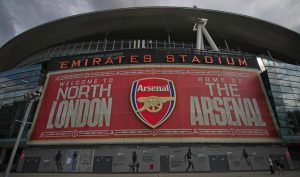
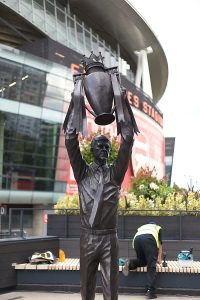


I am pleased AW finally got a statue but tbh I find it odd looking. The arms are too long. Look at the photo it’s based on. The trophy is nowhere near as high above his head.
Well how ironic that the founder of the Arsenal history site (I believe this is so)has pioneered such an idea to both preserve and promote the history of this iconic club. Arsenal football club has probably played a bigger part in the evolution of the game more than any other club, first through Chapman era of the building of the east and west stands making it the first mega stadium of its time,undersoil heating,numbers on shirts, floodlighting and having the first game of football ever televised live. Follllowed by Wenger era of modernisation, diet, stretching and super slick football pitches with proper drainage and the foresight that we had to move and build the Emirates.. Regard yourself as part of that amazing history of Arsenal football club Tony.